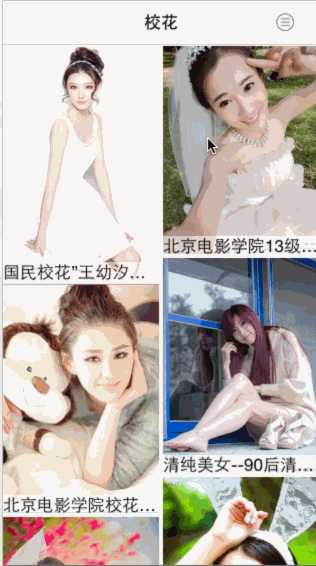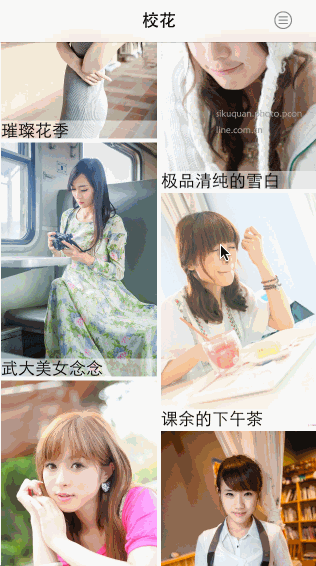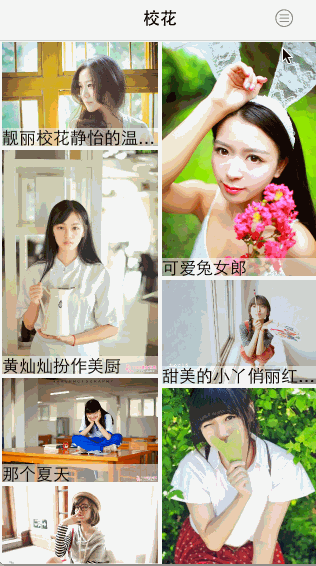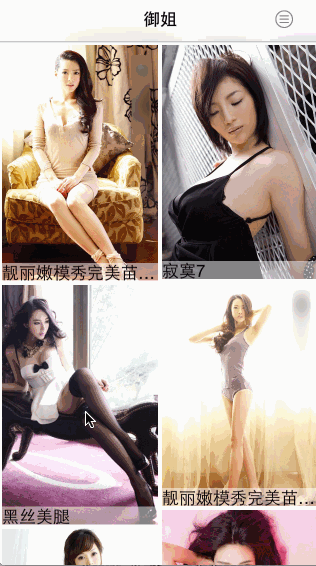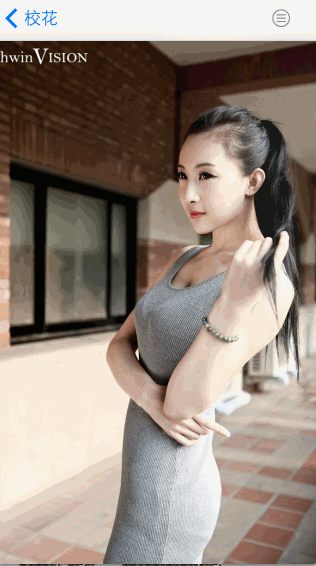美女圖片採集器 (源代碼+解析)
前言:
有一段時間沒寫博客了, "持之以恒"徽章都暗了, 實在不該。 前一段確實比較忙, ...小小地給自己的懶找個借口吧。
大二即將結束, 學習iOS也有一段時間了。今天抽點時間, 開源一個前幾天剛上傳的App裏面的一個功能, RT, 美女圖片採集器。 ? 美女.. 相信沒有人不喜歡吧, 基於此, 這個小Demo應運而生。
註:?
本文正在參加博客大賽。 假設認為對你有所幫助, 還望幫忙投下票。 多謝。
?
投票鏈接:?http://vote.blog.csdn.net/Article/Details?articleid=37825177 (投票button在最下方)
效果演示:
看到這裏, 假設還有興趣學習的話, 能夠先到我的git中下載源代碼, 然後配合著源代碼看我以下的解析。相信, 會讓你有所收獲的。
git下載鏈接:?BeautyPickDemo.git
涉及內容:
- 百度圖片API的使用
- JSON格式數據解析
- 圖片異步下載 + 離線緩存
- 圖片基本操作(縮放, 刪除, 加入, 保存到本地)
- 下拉刷新, 上提載入
- 幻燈片放映
- 自己定義後臺顯示圖片
源代碼解析:
一。百度圖片API的使用
首先, 我們知道百度是沒有對外開放圖片API的, 可是我們能夠通過谷歌瀏覽器來捕捉到訪問過程中它調用的API。有興趣的, 能夠了解下谷歌瀏覽器Network選項的使用, 也能夠參考下這篇文章:?百度圖片api這裏, 我們主要介紹怎樣使用就可以。tn=resultjsonavstar&ie=utf-8&word=劉德華&pn=0&rn=60
說明:
返回格式為json
word為查詢的內容
pn為第幾頁
rn為一頁返回的圖片數量
用法:大家在瀏覽器地址欄輸入上述地址,回車就可以看到返回的圖片地址
2.百度圖片分類API (我們使用的就是這個)http://image.baidu.com/channel/listjson?pn=0&rn=30&tag1=美女&tag2=所有&ie=utf8
http://image.baidu.com/channel/listjson?
pn=0&rn=30&tag1=美女&tag2=所有&ftags=校花&ie=utf8
至於其它的, 按照這種方法都能獲取到. 就不反復說明了。
至於怎樣調用API, 涉及到網絡編程。開源的ASI類庫做的比較好(盡管挺老的一個東西了, 也有一段時間沒更新了, 可是能滿足我們需求)。從源代碼中, 能夠找到 網絡請求ASI目錄。裏面有須要的文件
1。導入這裏的文件2。導入必須的框架, 包含:SystemConfiguration.framework
MobileCoreServices.framework
CFNetwork.framework
libz.dylib
3。調用API (參見 主界面-->picVC)
@property (nonatomic,strong) ASIHTTPRequest *testRequest;
NSString* urlString = [NSString stringWithFormat:@"http://image.baidu.com/channel/listjson?pn=%d&rn=10&tag1=美女&tag2=%@", nowPage, [chooseArr objectAtIndex:nowChoose]];
urlString = [urlString stringByAddingPercentEscapesUsingEncoding:NSUTF8StringEncoding];
NSURL *url = [NSURL URLWithString:urlString];
testRequest = [ASIHTTPRequest requestWithURL:url];
[testRequest setDelegate:self];
[testRequest startAsynchronous];就可以正常調用API。
至於怎樣處理返回的數據, 以下再詳細講。
二。
JSON格式數據解析一般的數據格式有XML和JSON, 這裏由於調用百度圖片API返回的數據格式是JSON, 所以我們僅僅要解析JSON就可以。調用API成功後, 它會自己主動運行這個函數
#pragma mark - 載入數據完成
- (void)requestFinished:(ASIHTTPRequest *)request這種方法返回的數據是二進制格式的NSData, 我們須要手動轉為UTF8編碼。能夠這樣獲取:
//當以二進制讀取返回內容時用這種方法
NSData *responseData = [request responseData];
NSString *responseString = [[NSString alloc] initWithData:responseData encoding:NSUTF8StringEncoding];接下去就是奇妙的時候了, 對於這種一個字符串, 假設直接打印, 你可能會看得雲裏霧裏的, json格式而且沒有又一次排列。可是我們能夠使用JsonKit來直接解析。(文件在json解析目錄中)
僅僅需這樣一條語句就可以:
self.testDic = [responseString objectFromJSONString];打印解析後的數據例如以下:

至於須要哪些, 直接取就好了。比方. 我們這裏須要獲取到圖片的標題. url, 寬度, 高度
NSMutableDictionary *nowDic = [[NSMutableDictionary alloc]init];
[nowDic setObject:[[array objectAtIndex:i]objectForKey:@"image_url"] forKey:@"image_url"];
[nowDic setObject:[[array objectAtIndex:i]objectForKey:@"image_width"] forKey:@"image_width"];
[nowDic setObject:[[array objectAtIndex:i]objectForKey:@"image_height"] forKey:@"image_height"];
[nowDic setObject:[[array objectAtIndex:i]objectForKey:@"desc"] forKey:@"desc"];
[picArray addObject:nowDic];三。圖片異步下載+離線緩存
這裏提一下SDWebImage, 我們將會使用它來實現。
詳細使用參見:SDWebImage 筆記在解析完json數據後, 我們會獲取到圖片相應的url。我們能夠通過訪問url獲取圖片。?
- (void)setImageWithURL:(NSURL *)url placeholderImage:(UIImage *)placeholder;
用法:
UIImageView *imageView = [[UIImageView alloc]initWithFrame:CGRectMake(SPACE / 2 , SPACE / 2 , width, height)];
NSURL *url = [NSURL URLWithString:imageInfo.thumbURL];
[imageView setImageWithURL:url placeholderImage:nil];
imageView.backgroundColor = [UIColor palePurpleColor];
[self addSubview:imageView];異步下載,離線緩存效果:(離線緩存能夠到應用沙盒中查看)


四。
圖片基本操作(縮放, 刪除, 加入, 保存到本地)
這裏涉及的主要是一些常規操作, 包含縮放, 刪除, 加入, 保存到本地等。至於刪除, 通常是長按刪除, 僅僅要在圖片上加上長按手勢響應就可以。然後彈出一個對話框, 提示用戶是否刪除。確定刪除後, 從沙盒中清除緩存就可以。加入手勢方法:
//長按
UILongPressGestureRecognizer *longRecognizer;
longRecognizer = [[UILongPressGestureRecognizer alloc]initWithTarget:self action:@selector(handleSingleLongFrom:)];
[self addGestureRecognizer:longRecognizer];從視圖和沙盒中刪除
//從當前視圖中刪除
[testArr removeObject:data];
//刷新數據
__weak picVC *blockSelf = self;
[blockSelf.waterView refreshView:testArr];
[blockSelf.waterView.infiniteScrollingView stopAnimating];
//從沙盒中刪除
//打開沙盒
NSArray *paths = NSSearchPathForDirectoriesInDomains(NSDocumentDirectory, NSUserDomainMask, YES);
NSString *documentsDirectory = [paths objectAtIndex:0];
NSString * namePath = [documentsDirectory stringByAppendingPathComponent:[NSString stringWithFormat:@"savedPicInfo_%d.plist",nowChoose]];
NSMutableArray *picArray = [[NSMutableArray alloc] initWithContentsOfFile:namePath];
for (int i=0; i<[picArray count]; i++)
{
if ([[[picArray objectAtIndex:i]objectForKey:@"image_url"] isEqualToString:data.thumbURL])
{
[picArray removeObjectAtIndex:i];
break;
}
}
[picArray writeToFile:namePath atomically:YES];至於縮放, 首先要彈出一個全屏顯示的視圖。像這樣:
//單擊, 顯示大圖
-(void)showImage:(ImageInfo*)data
{
NSURL *url = [NSURL URLWithString:data.thumbURL];
[clickImage setImageWithURL:url placeholderImage:nil];
TGRImageViewController *viewController = [[TGRImageViewController alloc] initWithImage:clickImage.image setImageInfo:data];
viewController.transitioningDelegate = self;
[self presentViewController:viewController animated:YES completion:nil];
}
本質就是調用presentViewController:viewController。當然。我們能夠給新視圖的顯示加上動畫效果, 例如以下:
#pragma mark - UIViewControllerTransitioningDelegate methods
- (id<UIViewControllerAnimatedTransitioning>)animationControllerForPresentedController:(UIViewController *)presented presentingController:(UIViewController *)presenting sourceController:(UIViewController *)source
{
if ([presented isKindOfClass:TGRImageViewController.class]) {
return [[TGRImageZoomAnimationController alloc] initWithReferenceImageView:clickImage];
}
return nil;
}
- (id<UIViewControllerAnimatedTransitioning>)animationControllerForDismissedController:(UIViewController *)dismissed {
if ([dismissed isKindOfClass:TGRImageViewController.class]) {
return [[TGRImageZoomAnimationController alloc] initWithReferenceImageView:clickImage];
}
return nil;
}然後, 在新視圖中, 加入點擊移除, 長按彈出新操作, 雙指移動縮放手勢就可以。
詳細實現例如以下:
#pragma mark - Private methods
- (void)longPress:(UITapGestureRecognizer *)tapGestureRecognizer
{
if(tapGestureRecognizer.state == UIGestureRecognizerStateBegan)
{
[self popupActionSheet];
}
}
- (IBAction)handleSingleTap:(UITapGestureRecognizer *)tapGestureRecognizer {
[self dismissViewControllerAnimated:YES completion:nil];
}
- (IBAction)handleDoubleTap:(UITapGestureRecognizer *)tapGestureRecognizer {
if (self.scrollView.zoomScale == self.scrollView.minimumZoomScale) {
// Zoom in
CGPoint center = [tapGestureRecognizer locationInView:self.scrollView];
CGSize size = CGSizeMake(self.scrollView.bounds.size.width / self.scrollView.maximumZoomScale,
self.scrollView.bounds.size.height / self.scrollView.maximumZoomScale);
CGRect rect = CGRectMake(center.x - (size.width / 2.0), center.y - (size.height / 2.0), size.width, size.height);
[self.scrollView zoomToRect:rect animated:YES];
}
else {
// Zoom out
[self.scrollView zoomToRect:self.scrollView.bounds animated:YES];
}
}五。
下拉刷新, 上提載入這個功能詳細在瀏覽圖片的時候使用。 代碼在picVC中。
可是由於我之前專門寫過一篇這種博客。 就不再反復了。詳細能夠看這裏:?iOS開發-ios7下拉刷新,上提載入高速集成
六。幻燈片放映
顧名思義, 就是能夠自己主動播放收藏過的美女圖片.. ?這裏的原理是利用UIView的動畫, 不斷切換顯示圖片和顯示效果。切換效果例如以下:
_transitionOptions= @[[NSNumber numberWithInteger:UIViewAnimationOptionTransitionFlipFromLeft],
[NSNumber numberWithInteger:UIViewAnimationOptionTransitionFlipFromRight],
[NSNumber numberWithInteger:UIViewAnimationOptionTransitionCurlUp],
[NSNumber numberWithInteger:UIViewAnimationOptionTransitionCurlDown],
[NSNumber numberWithInteger:UIViewAnimationOptionTransitionCrossDissolve],
[NSNumber numberWithInteger:UIViewAnimationOptionTransitionFlipFromTop],
[NSNumber numberWithInteger:UIViewAnimationCurveEaseIn],
[NSNumber numberWithInteger:UIViewAnimationCurveEaseOut],
[NSNumber numberWithInteger:UIViewAnimationCurveLinear],
[NSNumber numberWithInteger:UIViewAnimationOptionAllowAnimatedContent],
[NSNumber numberWithInteger:UIViewAnimationOptionOverrideInheritedCurve],
[NSNumber numberWithInteger:UIViewAnimationOptionTransitionFlipFromTop],
[NSNumber numberWithInteger:UIViewAnimationOptionTransitionFlipFromBottom]];然後切換圖片的時候, 實現例如以下代碼就可以。
?(詳細參見PhotoStackView)
-(void)reloadData {
if (!self.dataSource) {
//exit if data source has not been set up yet
self.photoViews = nil;
return;
}
NSInteger numberOfPhotos = [self.dataSource numberOfPhotosInPhotoStackView:self];
NSInteger topPhotoIndex = [self indexOfTopPhoto]; // Keeping track of current photo‘s top index so that it remains on top if new photos are added
if(numberOfPhotos > 0) {
NSMutableArray *photoViewsMutable = [[NSMutableArray alloc] initWithCapacity:numberOfPhotos];
UIImage *borderImage = [self.borderImage resizableImageWithCapInsets:UIEdgeInsetsMake(self.borderWidth, self.borderWidth, self.borderWidth, self.borderWidth)];
for (NSUInteger index = 0; index < numberOfPhotos; index++) {
UIImage *image = [self.dataSource photoStackView:self photoForIndex:index];
CGSize imageSize = image.size;
if([self.dataSource respondsToSelector:@selector(photoStackView:photoSizeForIndex:)]){
imageSize = [self.dataSource photoStackView:self photoSizeForIndex:index];
}
UIImageView *photoImageView = [[UIImageView alloc] initWithFrame:(CGRect){CGPointZero, imageSize}];
photoImageView.image = image;
UIView *view = [[UIView alloc] initWithFrame:photoImageView.frame];
view.layer.rasterizationScale = [[UIScreen mainScreen] scale];
view.layer.shouldRasterize = YES; // rasterize the view for faster drawing and smooth edges
if (self.showBorder) {
// Add the background image
if (borderImage) {
// If there is a border image, we need to add a background image view, and add some padding around the photo for the border
CGRect photoFrame = photoImageView.frame;
photoFrame.origin = CGPointMake(self.borderWidth, self.borderWidth);
photoImageView.frame = photoFrame;
view.frame = CGRectMake(0, 0, photoImageView.frame.size.width+(self.borderWidth*2), photoImageView.frame.size.height+(self.borderWidth*2));
UIImageView *backgroundImageView = [[UIImageView alloc] initWithFrame:view.frame];
backgroundImageView.image = borderImage;
[view addSubview:backgroundImageView];
} else {
// if there is no boarder image draw one with the CALayer
view.layer.borderWidth = self.borderWidth;
view.layer.borderColor = [[UIColor whiteColor] CGColor];
view.layer.shadowOffset = CGSizeMake(0, 0);
view.layer.shadowOpacity = 0.5;
}
}
[view addSubview:photoImageView];
view.tag = index;
view.center = CGPointMake(CGRectGetMidX(self.bounds), CGRectGetMidY(self.bounds));
[photoViewsMutable addObject:view];
}
// Photo views are added to subview in the photoView setter
self.photoViews = photoViewsMutable; photoViewsMutable = nil;
[self goToPhotoAtIndex:topPhotoIndex];
}
}
七。自己定義後臺顯示圖片
這個功能就是演示效果裏面, 當應用切換到後臺後, 我們雙擊home鍵後顯示後臺程序時候, 該應用的顯示效果。比方.. ?有時候我們瀏覽的圖片尺度比較大.. 然後切到後臺的時候, 就希望把它隱藏起來.. ?這就涉及到了Background Fetch的應用。之前也寫過一篇博客專門介紹。 這裏就不反復了。
詳細參見:?iOS開發-自己定義後臺顯示圖片(iOS7-Background Fetch的應用)
好了。 到這裏最終是介紹的幾乎相同了。當然。 我這裏的解析都比較概括, 列舉的都是幾個關鍵代碼段。更加詳細的還是須要自己去看代碼。 凝視也寫了, 預計沒什麽問題。 假設有問題, 歡迎聯系我。
一口氣寫了3個小時的博客... ?累的夠嗆的。也希望, 能對你有所幫助。
本文正在參加博客大賽。
假設認為對你有所幫助, 還望幫忙投下票。
多謝。?
投票鏈接:?http://vote.blog.csdn.net/Article/Details?
articleid=37825177 (投票button在最下方)
學習的路上, 與君共勉。
美女圖片採集器 (源代碼+解析)

